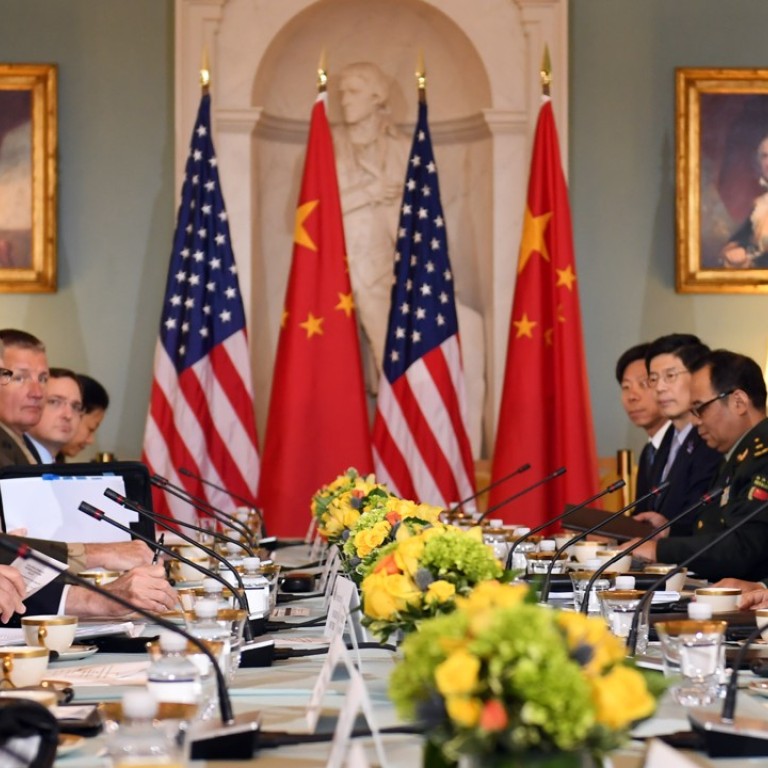
Trump, China defy sceptics with stable ties, but will it last?
US administration and Beijing proved at this week’s security dialogue they have developed a solid working relationship, but deep-rooted tensions remain unresolved, writes Ankit Panda
The dialogue roughly amounted to what is commonly described as a “two-plus-two” format, with Secretary of State Rex Tillerson and Secretary of Defence James Mattis representing the United States, and State Councillor Yang Jiechi leading the Chinese side, flanked by the chief of the People’s Liberation Army’s joint staff department, General Fang Fenghui.
Ahead of the dialogue, Tillerson had testified at a US Budget hearing about the state of the US-China relationship. He presented a forward looking view of the big questions surrounding the world’s two superpowers. He underlined three major areas of strategic uncertainty that would continue to bedevil the US-China relationship: the sustainability of the ‘one-China’ policy, the North Korean question, and China’s behaviour in the South China Sea.
Kim Jong-un has also directed the Pukkuksong-2 medium-range ballistic missile into mass production and declared initial operating capability for a new surface-to-air missile system. North Korea additionally displayed a new coastal defence cruise missile launcher.
The day before the dialogue, Trump sought to set the mood by taking to Twitter, as he is known to do, to note that while he “greatly appreciate[d] the efforts of President Xi & China to help with North Korea”, things had “not worked out.”
The implication was clear: Trump was seeking to signal to General Fang and State Councillor Yang that the time had come for serious sanctions enforcement against North Korea. Despite Trump’s move on social media, Tillerson, at the conclusion of the dialogue, emphasised that all the US did was communicate its seriousness on this issue to the Chinese. The two sides did agree that firms within their jurisdictions should “not do business” with sanctioned North Korean entities – a positive development.
On the South China Sea, the dialogue appears to have been underwhelming, representing something like a reversion to the mean on US-China tension over the issues coming after the Trump administration authorised its first freedom of navigation operation in the region in late May and Mattis delivered forceful remarks on the subject at the Shangri-La Dialogue in Singapore earlier this month.
In fact, Tillerson was quite charitable to the Chinese position on the matter, telling the press that China had “committed to resolve their disputes peacefully and in accordance with recognised principles of international law, including the UN Convention on the Law of the Sea”.
This was a particularly surprising utterance from the top US diplomat given Beijing’s refusal to acknowledge the validity of the now near year-old ruling by a five-judge tribunal at the Hague on the South China Sea, which found various Chinese claims, including the so-called ‘nine-dash line’, invalid under the UN convention.
Still, Tillerson noted that the two sides had “frank exchanges”. Yet, for all his concessions to Beijing on the South China Sea, Tillerson did point out that he took Beijing to task over its human rights record in a “candid” manner – a first from an administration that has largely shirked US normative leadership in the area.
Neither Tillerson nor Mattis suggested that anything regarding Taiwan or the United States’ “One- China” policy had come up during the dialogue. This was despite Tillerson’s testimony earlier in June that the sustainability of the One China’ policy “for the next 50 years” was part of ongoing US-China discussions. The issue came to a head during the presidential transition when Trump received am unprecedented phone call from Taiwanese President Tsai Ing-wen. Analysts also expect the administration to announce a new arms package for Taipei sometime this summer. China’s sensitivities on Taiwan remain amply clear and the topic does not appear to be on the agenda.
The inaugural Diplomatic and Security Dialogue, in the end, appears not to have resulted in any dramatic outcomes. Despite the high-level participation, the forum served primarily to reiterate priorities for both Beijing and Washington, with neither side walking away with major takeaways. On North Korea, the South China Sea and other issues, the two sides will maintain divergent interests and policies. What remains remarkably positive is the ability of both sides to maintain a relatively stable and cooperative relationship, despite expectations to the contrary among many observers earlier this year following Trump’s inauguration. The question going forward will be if that momentum will last or if these perennial questions that underlie and strain the US-China relationship with reach a slow boil, injecting the relationship with new turbulence.
Ankit Panda is senior editor at The Diplomat where he writes on international security, diplomacy and economics in the Asia-Pacific region

